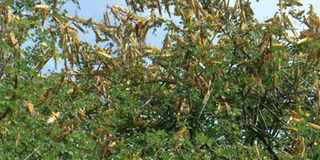Two locust swarms enter Uganda

Swarm. The desert locusts in Amudat District yesterday. PHOTO BY GILLIAN NANTUME
What you need to know:
- Dr Micheal Kaziro, the Amudat veterinary officer, said no tests were done on the drugs to prove their safety prior to the spraying.
- Earlier Wednesday, about 100 soldiers from Olilim Army Barracks, headed by Brig Steven Oluka, the head of the emergency response unit of the Uganda People’s Defence Forces (UPDF), camped in Katakwi District, hoping to spray a swarm that entered the district on Tuesday evening.
At about 3pm yesterday, a huge swarm of locusts entered Uganda from Kenya’s Kasai region and officials estimate it to comprise more than 40 million insects.
They said the locusts entered through Nakasepan Village in Amudat Sub-county, Amudat District. Two hours later, another swarm entered through Komoret in Amudat.
The locusts did not spend more than an hour in one place.
The swarm that landed in Nakasepan rested on the sparse vegetation for a while, before moving towards Nakapiripirit District.
This prompted district officials to alert the locust surveillance task force in Moroto District to intercept them before they get to Nakapiripirit.
Mr Robert Kimanaye, the Amudat production officer, said spraying will now begin.
“We have reports that there is another swarm still stuck at the other side of the border. We are beginning preparations at the district level to block them by spraying them. As we wait for supplies from Moroto, we will begin by using the motorised pumps we already have here. We hope to be reinforced by the planes which will arrive from Moroto,” he said.
Earlier Wednesday, about 100 soldiers from Olilim Army Barracks, headed by Brig Steven Oluka, the head of the emergency response unit of the Uganda People’s Defence Forces (UPDF), camped in Katakwi District, hoping to spray a swarm that entered the district on Tuesday evening.
However, by the time they arrived, the locusts had left and were reportedly heading to Kitgum District.
Veterinarians have expressed worry over the aerial spraying of locusts, saying the effects of the drugs on livestock and humans in the largely pastoral region, could be devastating.
Veterinarians call for caution
Dr Micheal Kaziro, the Amudat veterinary officer, said no tests were done on the drugs to prove their safety prior to the spraying.
“This is dangerous because with aerial spraying, you are contaminating pastures at various levels. We are going to have a contaminated district herd and we all know the effects of chemicals in our bodies. If the animals do not die, we will have animals carrying these pesticides in meat and milk that we are going to consume,” he said.
Dr Kaziro also said he hoped the livestock sector will also be supported with its own interventions to fight the locusts.
“Everyone is looking at the crop side, but this region is 90 per cent pastoral. They should carry out selective spraying. I would not advise them to spray everywhere. Bee keeping is also an economic activity here and the production of honey will drop because when spraying begins, the bees will die,” he said.
“Our people depend on honey for food. That is why we do not have many cases of child malnutrition as it is in other districts in Karamoja region,” he added.




